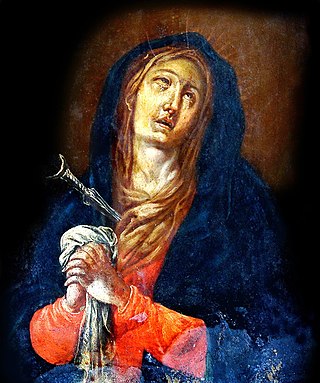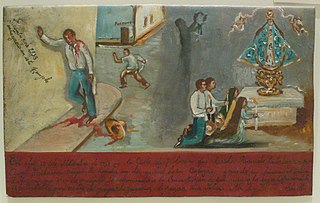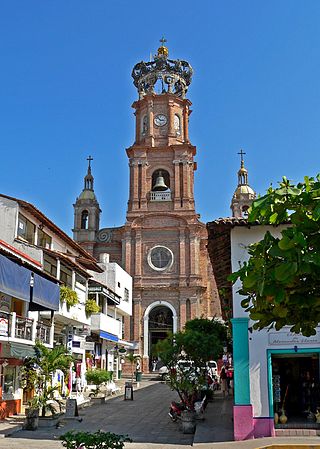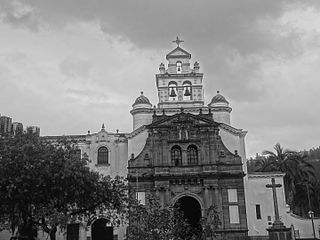Chapters
Maravilla Americana is divided into eight chapters:
Chapter I
"On the Awesome Durability of the Image of Our Lady of Guadalupe". In Chapter 1, Cabrera discusses the durability of the portrait fibers, which had not degraded in more than 225 years. He took special note of the very thin cotton thread that united both parts of the ayate, which by itself couldn't resist the least force, remaining in place. Cabrera concluded that the fibers had lasted because the "Holy Image" of the saint was stamped on them.
Chapter II
"As to the Cloth or Canvas on Which Our Lady is Depicted". In Chapter 2, Cabrera analyzes the source of the portrait fibers. One possibility is that the fibers derive from palm trees. He dismisses the maguey plant as being too coarse for use in a portrait. Cabrera also suggests that the fiber is a middle quality European twine known as “cotense”. He concludes: “What excites admiration is the softness to the touch, it feels like silk”. But the fiber certainly doesn’t look like silk! To the sight the woof is coarse, the quality is middle.
Chapter III
"On the total absence of priming in this painting". In Chapter 3, Cabrera, said that the Guadalupan Portrait does not contain any varnish primer. This is normally required on a painting canvas; painting on a coarse fabric without varnish is impossible.
Chapter IV
"On the marvellous drawing of Our Lady of Guadalupe". In Chapter 4, Carbrera remarks on the fine quality of the Guadalupan portrait drawing: “It is unmatched; and so perfectly finished, and marvellous, that I’m fully certain that whoever with elementary knowledge of the principles of this art, on seeing it, will exceed himself in eloquence to make this portent known as miraculous”. After a long eulogy, he describes the drawing in detail.
Chapter V
"On the four different schools of painting which concur marvellously in the image of Our Lady of Guadalupe". It would be a great monstrosity to find in nature a being composed of four different animal species; no less do I consider a painting of which, in a single canvass, four different species of painting concurred in its single surface. However, this which to a human artist would be dissonant and even tasteless, we see here divinely practiced in this virginal canvass with such grace and beauty, that no matter how much I wished to exaggerate, I could never say as much as it by itself conveys to the onlooker’s eyes. More than human was the hand…etc. The four species or ways of painting are: in oil, in tempera, in gouache and in fresco…And after explaining each with its difficulty, and total lack of precedent for a single surface to the point that before Guadalupe no one could have imagined it, he says: “to me, its so efficacious, that it persuades me of its miraculous character.”
Chapter VI
"On the precious gold and exquisite gilding of the miraculous image of Our Lady of Guadalupe". In Chapter 6, Cabrera discuss the strange color of the portrait gilding. He is very impressed that the gold seems to be fused into the fibers themselves: “...because I noticed that all that’s gilded is so united to the canvass, that to the touch it can be only be felt by the concavity as if it were printed; a matter for weighty consideration, as there’s no material in the canvas of the type used for gilding... The Holy Image has its tunic gilded with some flowers of strange design. They are composed of a golden vein with the peculiarity that they follow not the pleats and undulations, but are continuous as if on a flat surface…”
Chapter VII
"Considerations on the objections against the esthetical perfection of the Image". In Chapter 7, Cabrera refutes Art criticism that claims the portrait violates what are called the "rules of painting": “The most thorough and efficacious answer to all objections presented or possible is the image itself, as I know that when attentively observed, the sharpest eyes will find no less than the complete achievement of the most perfect whole that painting ever admired.”
Chapter VIII
"On the design of the miraculous image of Our Lady of Guadalupe."

Our Lady of Guadalupe, also known as the Virgin of Guadalupe, is a Catholic title of Mary, mother of Jesus associated with a series of five Marian apparitions to a Mexican peasant called Juan Diego and his uncle, Juan Bernardino, which are believed to have occurred in December 1531.

Our Lady of the Rosary of Chiquinquirá or the Virgin of Chiquinquirá is a Marian title of the Blessed Virgin Mary associated with a venerated image in the northern Andes region.

The Basilica of Santa María de Guadalupe, officially called Insigne y Nacional Basílica de Santa María de Guadalupe is a sanctuary of the Catholic Church, dedicated to the Virgin Mary in her invocation of Guadalupe, located at the foot of the Hill of Tepeyac in the Gustavo A. Madero borough of Mexico City. It belongs to the Primate Archdiocese of Mexico through the Guadalupana Vicariate, which since November 4, 2018, is in the care of Monsignor Salvador Martínez Ávila, who has the title of general and episcopal vicar of Guadalupe and abbot of the basilica.

Luis Laso de la Vega was a 17th-century Mexican priest and lawyer. He is known chiefly as the author of the Huei tlamahuiçoltica, an account published in 1649 and written in the Nahuatl language, which contains a narrative describing the reported apparition of the Virgin Mary before Saint Juan Diego in 1531, some 117 years earlier. The account describes the appearance of the apparition now known as Our Lady of Guadalupe to Juan Diego at the hill of Tepeyac.
Juan Diego Bernardino was one of two Aztec peasants alleged to have had visions of the Virgin Mary as Our Lady of Guadalupe in 1531.

Huei Tlamahuiçoltica is a tract in Nahuatl comprising 36 pages and was published in Mexico City, Mexico in 1649 by Luis Laso de la Vega, the vicar of the chapel of Our Lady of Guadalupe at Tepeyac outside the same city. In the preface Luis Laso de la Vega claimed authorship of the whole work, but this claim is the subject of an ongoing difference of scholarly opinion.

Miguel Mateo Maldonado y Cabrera (1695–1768) was a Mestizo painter born in Oaxaca but moved to Mexico City, the capital of Viceroyalty of New Spain. During his lifetime, he was recognized as the greatest painter in all of New Spain. He created religious and secular art for the Catholic Church and wealthy patrons. His casta paintings, depicting interracial marriage among Amerindians, Spaniards and Africans, are considered among the genre's finest. Cabrera's paintings range from tiny works on copper to enormous canvases and wall paintings. He also designed altarpieces and funerary monuments.
Miguel Sánchez (1594–1674) was a Novohispanic priest, writer and theologian. He is most renowned as the author of the 1648 publication Imagen de la Virgen María, a description and theological interpretation of an apparition to Juan Diego of the Virgin Mary as Our Lady of Guadalupe which is the first published narrative of the event. The precise nature of the cult before that date and whether the tradition as to the apparition dates back to 1531, constitute a vexed historical problem. The existence of a cult of the Virgin Mary at a chapel at Tepeyac, focussed on a painted cult image of the Virgin and enjoying a reputation for miraculous healing, was certainly established by 1556. Professor Brading, a scholar of Mexican history, noted of Sánchez: "even if he did not initiate the devotion, he determined the manner in which the image was exalted and justified."

A canonical coronation is a pious institutional act of the pope, duly expressed in a formal decree of a papal bull, in which the pope bestows the pontifical right to impose an ornamental crown, a diadem or an aureole to an image of Christ, Mary or Joseph that is widely venerated in a particular diocese or locality.

Codex Escalada is a sheet of parchment signed with a date of "1548", on which there have been drawn, in ink and in the European style, images depicting the Marian apparition of Our Lady of Guadalupe to Juan Diego which allegedly occurred on four separate occasions in December 1531 on the hill of Tepeyac north of central Mexico City. If authentic, and if correctly dated to the mid-16th century, the document fills a gap in the documentary record as to the antiquity of the tradition regarding those apparitions and of the image of the Virgin associated with the fourth apparition which is venerated at the Basilica of Guadalupe. The parchment first came to light in 1995, and in 2002 was named in honour of Fr. Xavier Escalada S.J. who brought it to public attention and who published it in 1997.

Colombian art has 3500 years of history and covers a wide range of media and styles ranging from Spanish Baroque devotional painting to Quimbaya gold craftwork to the "lyrical americanism" of painter Alejandro Obregón (1920–1992). Perhaps the most internationally acclaimed Colombian artist is painter and sculptor Fernando Botero (1932).

Our Lady of Sorrows of Turumba is a Roman Catholic dolorous painted image of the Blessed Virgin Mary as Our Lady of Sorrows, enshrined in Pakil, Laguna, Philippines.
Informaciones Jurídicas de 1666 is a Spanish document that helped support the apparition of the Virgin Mary to Juan Diego Cuauhtlatoatzin at the hill of Tepeyac in 1531. The apparition is also known today as the iconic Virgin of Guadalupe. The Proceedings of 1666 consist of a series of investigations, record examinations, testimonies from artists, physicians, and Aztec historians, and oral accounts from elderly men and women who had knowledge and experience with Juan Diego and his contemporaries.

Within Catholicism, a miracle of the roses is a miracle in which roses manifest an activity of God or of a saint. Such a miracle is presented in various hagiographies and legends in different forms, and it occurs in connection with diverse individuals such as Saints Elizabeth of Hungary (1207–1231), Elizabeth of Portugal (1271–1336), Saint Dorothy, a 4th-century virgin martyr at Caesarea in Cappadocia, and Our Lady of Guadalupe.
Our Lady of Luján is a celebrated 16th-century statue of the Virgin Mary, mother of Jesus Christ. The image, also known as the Virgin of Luján, is on display in the Basilica of Luján in Argentina. The feast day of Our Lady of Luján is May 8.

Votive paintings in Mexico go by several names in Spanish such as “ex voto,” “retablo” or “lámina,” which refer to their purpose, place often found, or material from which they are traditionally made respectively. The painting of religious images to give thanks for a miracle or favour received in this country is part of a long tradition of such in the world. The offering of such items has more immediate precedence in both the Mesoamerican and European lines of Mexican culture, but the form that most votive paintings take from the colonial period to the present was brought to Mexico by the Spanish. As in Europe, votive paintings began as static images of saints or other religious figures which were then donated to a church. Later, narrative images, telling the personal story of a miracle or favor received appeared. These paintings were first produced by the wealthy and often on canvas; however, as sheets of tin became affordable, lower classes began to have these painted on this medium. The narrative version on metal sheets is now the traditional and representative form of votive paintings, although modern works can be executed on paper or any other medium.

Juan Diego Cuauhtlatoatzin, also known as Juan Diego, was a Chichimec peasant and Marian visionary. He is said to have been granted apparitions of the Virgin Mary on four occasions in December 1531: three at the hill of Tepeyac and a fourth before don Juan de Zumárraga, then bishop of Mexico. The Basilica of Our Lady of Guadalupe, located at the foot of Tepeyac, houses the cloak (tilmahtli) that is traditionally said to be Juan Diego's, and upon which the image of the Virgin is said to have been miraculously impressed as proof of the authenticity of the apparitions.
Marcos Cipac de Aquino (?–1572), informally known as Marcos the Indian, was a Roman Catholic Nahuatl artist in sixteenth-century Mexico, who may have been the painter of the image of the Virgin of Guadalupe. Art historian Jeanette Favrot Peterson has ventured "Marcos Cipac was the artist of the Mexican Guadalupe, capable of executing a large Marian painting on cloth within a professional milieu that was abundantly stock to stimulate his innate artistry.". The basis of her conjecture is evidence in the Anales de Juan Bautista, a manuscript housed in the Biblioteca Boturini of the Basilica of Guadalupe and translated and published in 2001. Mexican scholars of the nineteenth century posited the painting's artist as Marcos Cipac de Aquino, including Joaquín García Icazbalceta in his "Carta acerca del Origen de la Imagen de Nuestra Sra. de Guadalupe" (1883) and Francisco del Paso y Troncoso's "Noticia del indio Marcos y de otros pintores del siglo XVI" (1891). There is some skepticism about the identification of the painting with Cipac Aquino. He is identified by a 1556 sermon, which referred to him only as Marcos. This sermon came to light only in 1888. Marcos de Aquino is credited with the painting also by Leoncio Garza-Valdés on the basis of a scientific investigation.

The Church of Our Lady of Guadalupe, known locally as the Iglesia de Nuestra Señora de Guadalupe, is a Catholic place of worship in Puerto Vallarta on the Pacific Coast of Mexico. It is open daily, with services in English available on Saturdays and mass in both Spanish and English on Sundays. The Church, built between 1930 and 1940, was constructed on the original foundations of a chapel initially dedicated to Lady Guadalupe in 1901. The Church is dedicated to Our Lady of Guadalupe, also known as the Virgin Mary. She is the patron saint of Mexico and is considered a religious symbol of Catholic faith and female empowerment. Her feast day on 12 December is also the date of her first apparition. To celebrate this festival (fiesta), many individuals in the Mexican community display altars in their homes consisting of a painting of Our Lady of Guadalupe surrounded by flowers, candles, and other individual touches. During this time, members of many churches, including the church in Puerto Vallarta, light fireworks after the evening rosary leading up to the 12th of December, the day in 1531 that La Virgen de Guadalupe had her first interaction with a Mexican man named Juan Diego, which essentially established Catholicism in Mexico. She is depicted as a dark-skinned woman whose dialect is Nahuatl, which is Juan Diego's native language. Originally classified as a symbol of religion and faith, her significance in current times surpasses her role in Catholicism. Today, some see her as a figure of Mexican patriotism and liberation.

The Church and Monastery of Our Lady of Guápulo was the first Marian shrine in what is now the Republic of Ecuador, founded in 1620 in Guápulo, a beautiful corner located northeast of the city of Quito, the capital of the country, located at 2,690 meters above sea level. Friar Juan de Dios Navas affirmed that this Shrine is one of the best relics inherited from the Colony. The image of the Virgin of Guápulo was the model used for the sculpture of Our Lady of El Cisne and also that of El Quinche.















